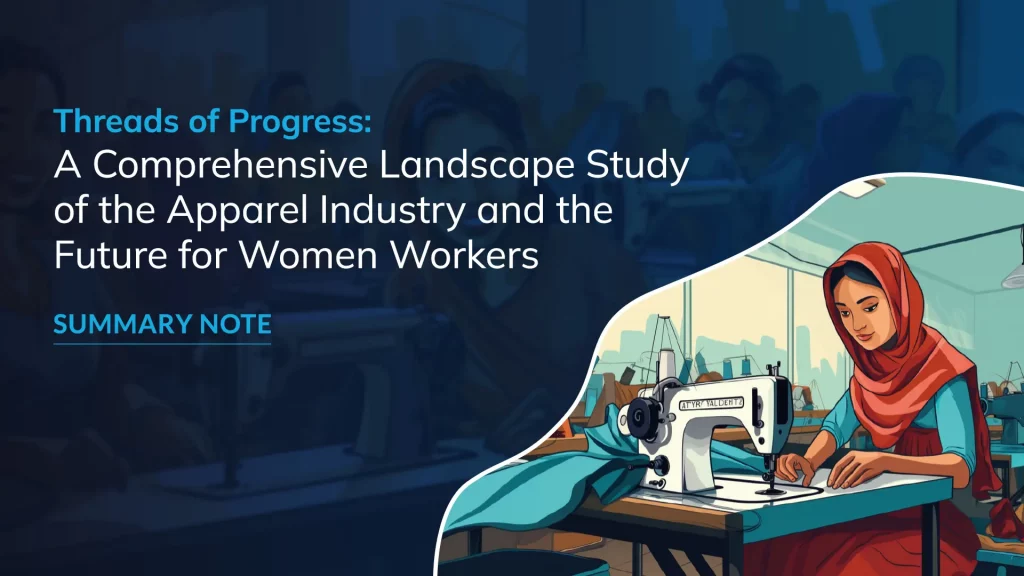
Threads of Progress: A Comprehensive Landscape Study of the Apparel Industry and the Future of Women Workers
Background
Bangladesh’s apparel sector has performed commendably over the last three decades, securing the second most prominent position in the global apparel market. Currently, with 3,500 operational clothing factories and a total investment of USD 20 billion, this industry makes up 11% of the GDP and directly sustains over 4 million jobs. (BGMEA, Aug 2023). However, despite growing in value and volume, the industry has primarily languished in the low-value segment attaining slim profit margins.
The changes in the fashion industry with the emerging concepts of fast and ultra-fast fashion, Bangladesh has been slowly losing out of its edge of cost-competitiveness as cost efficiency is not the only requirement anymore. Faster production and reduced lead time are needed to stay on top of the industry.
With the global fashion industry demanding ultra-fast fashion products, there has been an emerging need for faster production resulting in apparel giants moving their production hubs from offshore cost-efficient countries to onshore locations with much lower lead time. In order to regain their competitiveness, global apparel manufacturing hubs like Bangladesh are gradually transitioning towards adopting automation into its production process and increasing efficiency to shorten the sector’s export lead time. In a world with a fragmented Ready-made Garment (RMG) industry using manual production, adoption of automation in the apparel manufacturing process of Bangladesh is still limited.
According to a report published by Foundation Strategy Group (FSG) as a part of the Collective Impact initiative on Future of Work for Women Garment workers in Bangladesh, less than 15% of garment manufacturing activities in Bangladesh are automated, and production is largely manual and labor-intensive. The report further highlighted that the apparel market structure is dominated by smaller factories, with at least 50% of factories being small or medium-sized.1
However, the pace of automation is gradually growing in the apparel sector, jeopardizing jobs, particularly for women in low-wage positions hindered by socio-cultural barriers. The proportion of women in the workforce dropped from 90% in 1980 to 59% in 2020.2
They often lack training to adapt to evolving factory technologies and face gender biases hindering their progress. Women also experience skill and education gaps compared to male counterparts; 29% lack primary education versus 18% of men. Men operate a wider range of machinery. Gender perceptions limit women’s representation in supervisory (below 15%) and managerial roles (below 5%) due to stereotypes about productivity.2
Furthermore, LDC graduation in 2026 will end preferential treatment from the European Union, impacting cost competitiveness and increasing the demand for efficient and automated production.
While automation and digitalization will help enhance sector competitiveness but will also pose a risk of substantial job losses, potentially affecting over 60% of the RMG workforce by 2041.2 Women workers, who are the majority in the sector, face the greatest vulnerability as they are overrepresented in low-paid, low-skilled positions. With these ongoing shifts in the apparel sector, it is imperative to equip the women garment workers in Bangladesh for a future where the textile industry is defined by automation and digitalization in order to safeguard their livelihoods.
To drive systematic change, LightCastle Partners in collaboration with Policy Exchange of Bangladesh has introduced BUNON 2030 and devised a comprehensive approach that includes conducting a landscaping study and engaging in policy advocacy through dialogue series and a national level dissemination session.
The landscaping study can act as a guide to assess the future of work. It used a scenario mapping framework to predict the effects of various global shifts, such as automation, circularity, worker well-being, and policy priorities. This analysis will facilitate systematic change and provide guidance for stakeholders to comprehend how to navigate different future uncertainties. The scenario analysis, along with the policy brief, will aid industry leaders and policymakers in proactive planning and adapting to evolving circumstances.
Objective of the Initiative
- Sketch a global snapshot of upcoming RMG trends and possible changes
- Assess the upcoming technological shift in the apparel industry
- Explore the effect circularity can have on the apparel sector
- Evaluate the impact on the apparel worker – future of work
- Provide the steps to be undertaken by stakeholders as per mapped scenarios

|
Interested to learn more? |

